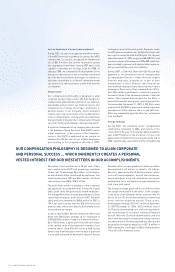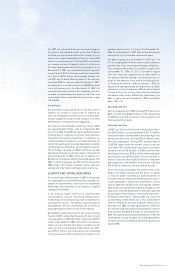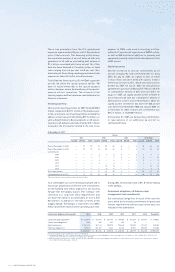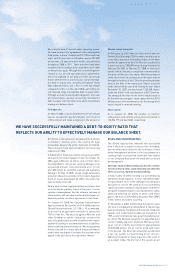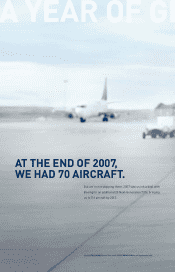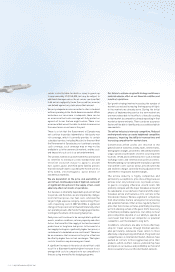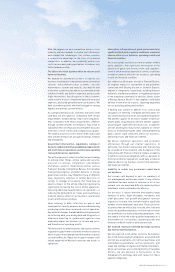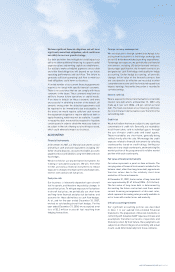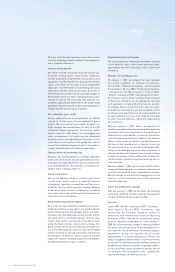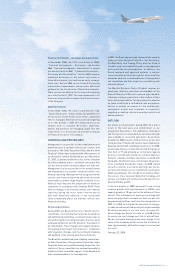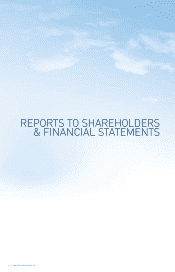Westjet 2007 Annual Report Download - page 32
Download and view the complete annual report
Please find page 32 of the 2007 Westjet annual report below. You can navigate through the pages in the report by either clicking on the pages listed below, or by using the keyword search tool below to find specific information within the annual report.
PAGE 30 WESTJET ANNUAL REPORT 2007
carrier is strictly liable for death or injury to guests up
to approximately US $145,000, but may be subject to
additional damages unless the air carrier can show that
it did not act negligently. Under the second tier, a carrier
can defend against any claim above that amount.
We carry adequate insurance similar to other scheduled
airlines operating in the North American market. While
we believe our insurance is adequate, there can be
no assurance that such coverage will fully protect us
against all losses that we might sustain. There is no
assurance that we will be able to obtain insurance on
the same terms as we have in the past.
There is a risk that the Government of Canada may
not continue to provide indemnity for third party war
risk coverage, which it currently provides to certain
scheduled carriers, including WestJet. In the event that
the Government of Canada does not continue to provide
such coverage, such coverage may or may not be
available to us in the commercial markets, and the costs
and impact of such costs is as yet undetermined.
The London aviation insurance market has announced
its intention to introduce a new standard war and
terrorism exclusion clause to apply to aircraft
hull, spares, guest and third party liability policies
that will exclude claims caused by the hostile use of a
dirty bomb, electromagnetic pulse device or
biochemical materials.
We are dependent on the price and availability of
aircraft fuel. Continued periods of high fuel costs and/
or signifi cant disruptions in the supply of fuel, could
adversely affect our results of operations.
Our business is inherently dependent upon aircraft fuel
to operate, and therefore, we are impacted by changes
in aircraft fuel prices. Our fuel costs constitute the
largest single expense category, representing 27 per
cent of operating costs in 2007 and 2006. A signifi cant
change in the price of aircraft fuel will materially affect
our operating results. We monitor hedging opportunities
to mitigate the effects of increasing fuel prices.
Fuel prices will continue to be susceptible to political
events, weather conditions, refi nery capacity and other
factors that can affect the supply of fuel and we cannot
predict near or long term fuel prices. In the event of a
fuel supply shortage or signifi cantly higher fuel prices, a
curtailment of scheduled service could result. There can
be no assurance that increases in the price of fuel can
be offset by higher fares or fuel surcharges. The higher
costs to travellers may discourage air travel.
A signifi cant increase in the price of aircraft fuel could
result in a disproportionately higher increase in our
average total costs in comparison to our competitors if
they are using more effective hedging programs.
Our failure to achieve our growth strategy could have a
material adverse effect on our fi nancial condition and
results of operations.
Our growth strategy involves increasing the number of
markets served and increasing the frequency of fl ights
to the markets we already serve. During the initial
phases of implementing service in a new market, we
are more vulnerable to the effects of fare discounting
in that market by competitors already operating in that
market or by new entrants. There can be no assurance
that we will be able to identify and successfully establish
new markets.
The airline industry is intensely competitive. Reduced
market growth rates can create heightened competitive
pressures, impacting the ability to increase fares and
increasing competition for market share.
Conventional airline profits are sensitive to the
general level of economic activity, taxes, interest rates,
demographic changes, price levels, telecommunications
usage, special circumstances or events occurring in the
locations served, and to external factors such as foreign
exchange rates and international political events.
Notwithstanding our variable profi t share plan, a portion
of an airline’s costs such as labour, aircraft ownership
and facilities charges cannot be easily adjusted in the
short term to respond to market changes.
The airline industry is highly competitive and
particularly susceptible to price discounting, because
airlines incur only nominal costs to provide services
to guests occupying otherwise unsold seats. We
primarily compete with the major Canadian airline and
its subsidiaries in our domestic market and the major
Canadian airline and numerous U.S. carriers in the
transborder market. We face signifi cant competition
from other airlines that are serving most of our existing
and potential markets. Other airlines regularly meet or
price their fares below our fares, potentially preventing
us from attaining a share of the guest traffi c necessary
to maintain profi table operations. Our ability to meet
price competition depends on our ability to operate at
costs lower than that of our competitors or potential
competitors over the medium to long term.
In addition, consumers are able to more effectively
shop for travel services through Internet websites
and, particularly, wholesale travel sellers to more
effectively compare pricing information. The growth and
competitiveness in Internet distribution channels have
pushed air carriers to more aggressively price their
products, which, in effect, reduces yield and may have
an impact on our revenue and profi tability as more and
more consumers focus on this distribution network.




